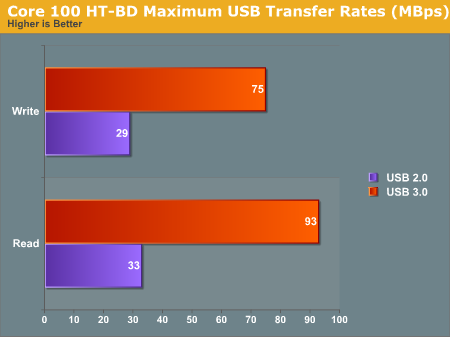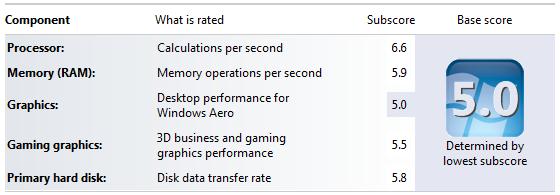ASRock Core 100HT-BD : Bringing HTPCs to the Mainstream Market [UPDATED : Noise Issue]
by Ganesh T S on July 19, 2010 9:34 PM EST- Posted in
- Home Theater
- Arrandale
- ASRock
- Media Streamer
- Core i3
- HTPC
Do the usual benchmarks really provide us with a proper indicator of the worthiness of a HTPC? Is that the performance seen by an average user in real life situations? Such questions often crossed my mind when I looked up the reviews of PCs on various websites. It is almost blasphemous if one were to suggest that the 'Windows Experience Index' is a reflection of what the average user sees. Such a synthetic benchmark might not be a true reflection of the capabilities of the system, but it at least gives an idea to the users as to how much better the system would be compared to the one they currently possess. HTPCs require a different set of performance measurement tests, and we will handle them in the next set of sections. In this, however, we will talk about the general performance metrics in brief.
For readers wanting a lowdown on the core performance aspect (in other words, graphs for various standardized benchmarks) of the motherboard used in this PC, I would suggest reviews from Legion Hardware and Benchmark Reviews. We found nothing in our experiments to dispute their findings. However, one important aspect we would like to cover here is the USB 3.0 performance.
USB 3.0 on the HM55 Chipset
We hooked up OCZ's Enyo 128 GB USB 3.0 external SSD (which has received glowing reviews everywhere with upto 200 MBps read and 190 MBps write speeds) to the front USB 3.0 ports of the Core 100 HT-BD. Contrary to our expectations, we managed to get a maximum of only 93 MBps read and 75 MBps write performance out of the drive. Connecting the same SSD to an USB 2.0 port resulted in a maximum of 33 MBps reads and 29 MBps writes, in line with expectations. We do not get the fabled 10x, but only a 2.7x, improvement over USB 2.0 with the Core 100 HT-BD's USB 3.0 implementation.

A little more analysis revealed that the HM55 chipset does not support PCI-E v2 fully and the bandwidth is limited by the chipset. To get around this limitation, ASRock could have placed a PLX bridge chip on board. We covered this workaround in detail in an earlier piece, but it doesn't make sense for ASRock to implement it in this product. The existing limitation will not be of concern to most users, as SSDs are yet to go mainstream (because of their cost). Most external hard disks with USB 3.0 or eSATA interfaces are inherently limited by the disk-to-buffer transfer rate of around 70 - 90 MBps, and ASRock's USB 3.0 implementation is capable of handling such bandwidth.
Windows Experience Index
A quick glance through the specifications of the system easily reveals the bottleneck affecting the score on the Windows Experience Index. It is none other than Intel's integrated GPU which ends up being the culprit. A screenshot of the Windows Experience Index shows the system chiming in at 5.0. However, we have seen the scores oscillate between 4.4 and 5.2 depending on the graphics driver version, as well as the GPU overclocking status.

Of particular interest is the impressive score received by the processor (6.6), indicating that the performance of this unit would be more than enough for most, if not all, HTPC applications.
DPC Latency Check
Another important criterion for HTPCs is the ability of the system to handle real time streaming of audio and video without dropouts. A handy tool called the DPC Latency Checker helps in analyzing this. This tool was run multiple times in various HTPC scenarios. We did observe red spikes, but disabling the C-states, as well as SpeedStep in the BIOS Advanced CPU configuration helped in alleviating the issue. However, we did not observe any dropouts or playback issues with Blu-Ray or any other media despite the sporadic occurrence of these spikes.
Miscellaneous Performance Indices
Pre-built HTPCs available today are mostly based on the ION chipset, and any comparative evaluation of the benchmark results of this system with ION systems would be grossly unfair for the ION. Both Benchmark Reviews and Legion Hardware compared the Core 100 HT with the ION 330, the 2009 HTPC model from ASRock. Comparing the performance of the Atom to the Core i3 is like comparing apples to oranges, but, for the record, the Core 100 HT system came out better on almost all counts except for the 3D and gaming performance.
On the memory bandwidth side, the Core 100 has more than 2x the performance of the ION 330. CPU performance is around 4 - 5x better. While games appeared to achieve almost similar frame rates on both the Core 100 and the ION 330, 3D performance in applications such as Maya went down by a factor of 2x in favour of the ION 330. Thankfully, applications such as video encoding (a common overnight task for most HTPCs) see a 3.5x performance improvement in the Core 100HT-BD.
In the next section, we will look at the integrated GPU of the Core i3-330M in detail.










107 Comments
View All Comments
GreeneEyez - Tuesday, July 20, 2010 - link
Have fun bitstreaming HD audio from the Mac Mini or playing back Blu ray disks/ISOs...ganeshts - Tuesday, July 20, 2010 - link
GeorgeH,It is not possible for any home built mini-ITX box to be within the power envelop of this unit.
This uses an Arrandale processor which isn't available for purchase by the general public.
Further, as you rightly observe, the MacMini has worse specs, but looks better. Companies like ASRock provide the best bang for the buck, and in this pursuit, industrial design takes a back seat. However, things are going in the right direction, and I am sure the execution next time around will be much better from all perspectives.
softdrinkviking - Tuesday, July 20, 2010 - link
i need a tv tuner in or connected to my htpc.you say that the 100HT-BD's chipset cannot support an internal TV tuner, but that it has a smaller power envelope than a chipset which can.
in that case, you would also have to factor in the extra power used by your external TV tuner box.
you would also have to compare the cost of that box versus the cost of a tuner card.
if all things are equal (you break even), then the all-in-one solution (a beefier htpc) would be the obvious choice.
tmservo - Tuesday, July 20, 2010 - link
As others mention, since the MacMini doesn't do Bluray, and doesn't bitstream DTS-MA or DD-HD, it's not really a great HTPC. It's LPCM support also troubled, and it doesn't matter since it doesn't do Bluray. The MacMini simply isn't a very good HTPC at all. It might compete against something like an ION.. except you can get an ION with BD at 1/2 the price. Apple has to give up rejecting the "bag of hurt" that is bluray, because as long as they keep their phobia of it, they aren't in the HTPC market at allComputer Bottleneck - Tuesday, July 20, 2010 - link
It will be interesting to see your future evaluation of the AMD IGP in the HQV 2.0 benchmark.As far as this product goes I really liked reading your technical explanation of how Asrock integrated what is basically a laptop mainboard into the Mini-ITX form factor.
alaricljs - Tuesday, July 20, 2010 - link
Can I suggest in that HTPC centric features chart that under SPDIF you specify optical/copper instead of just yes/no?ganeshts - Tuesday, July 20, 2010 - link
Thanks for your suggestion, alaricjls.The SPDIF is optical, and I will update the article shortly.
dbone1026 - Tuesday, July 20, 2010 - link
Hey Ganesh,Excellent job with the review. Honestly I am surprised by some of the comments regarding an expansion slot, which to me defeats the whole purpose of ASRock making this HTPC in such a small form factor. Aside from USB tuners I know many people who use network tuners (i.e HDHomeRun) so in many cases there is no need for any sort of internal tuner. If want to strap on multiple tuners then why not just a MicroATX or ATX case as that is not the intention of this ASRock..
I honestly think the biggest challenge with the ASRock 100HT is the price. Newegg has it listed at $649 (without BR drive) and no O/S. The mini-ITX HTPC I built which was only slightly larger and was easily $100 less with better specs (using core i5). Hopefully we start seeing prices drop soon.
jabber - Tuesday, July 20, 2010 - link
I've been rolling out the dual core Atom ones for small office/home PCs. The customers love them over the old big black/grey boxes.Low power and small desk presence are a big win.
Very nicely made too.
Built about sixteen of them and not one issue so far.
erictorch - Tuesday, July 20, 2010 - link
The core i3-330m processor is available for ordering from www.superbiiz.comIf the reviewer reads this comment, can they comment on whether AHCI support is available in the BIOS menus? This is necessary to get the full performance out of a SSD. A lot of laptop bioses don't have AHCI selectable.